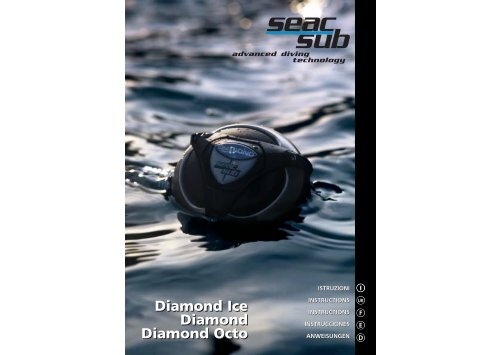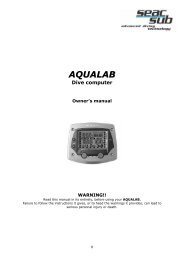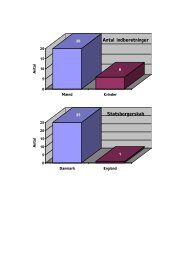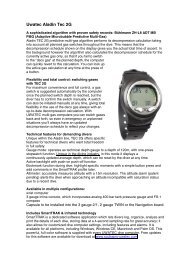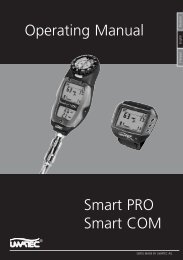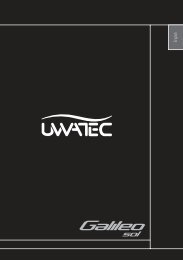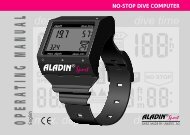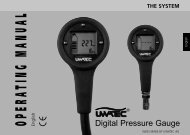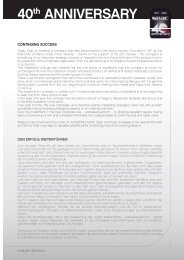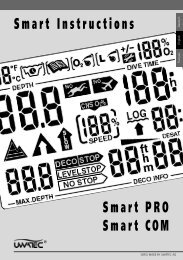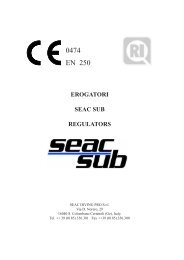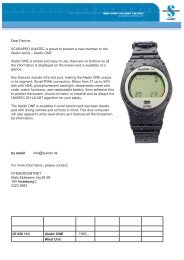Create successful ePaper yourself
Turn your PDF publications into a flip-book with our unique Google optimized e-Paper software.
<strong>Diamond</strong> <strong>Ice</strong><br />
<strong>Diamond</strong><br />
<strong>Diamond</strong> <strong>Octo</strong><br />
ISTRUZIONI<br />
INSTRUCTIONS<br />
INSTRUCTIONS<br />
INSTRUCCIONES<br />
ANWEISUNGEN<br />
I<br />
UK<br />
F<br />
E<br />
D
INDEX<br />
ITALIANO pag. 5<br />
ENGLISH pag. 13<br />
FRANÇAIS pag. 21<br />
ESPANOL pag. 29<br />
DEUTSCH pag. 37<br />
SEAC DIVING PRO srl<br />
Via D. Norero, 29<br />
16040 San Colombano Certenoli (GE), Italy<br />
Tel. +39 (0185) 356301<br />
Fax. +39 (0185) 356300<br />
Info: info@seacsub.com<br />
Web Page: www.seacsub.com<br />
<strong>Diamond</strong> <strong>Ice</strong><br />
<strong>Diamond</strong><br />
0474 - EN 250 : 2000<br />
EROGATORI<br />
REGULATORS<br />
DETENDEUR<br />
REGULADOR<br />
ATEMREGLER<br />
<strong>Diamond</strong> <strong>Octo</strong>
SEAC SUB ENGLISH<br />
14<br />
Congratulations for choosing the<br />
quality and reliability of a Seac Diving<br />
Pro product. The equipment you bought<br />
was produced using selected and tested<br />
materials. Our constant evolution<br />
results from continuous research and<br />
development. Innovative production<br />
processes, constant testing and actual<br />
functionality tests developed at our<br />
research centre guarantees the<br />
reliability characterizing all Seac Diving<br />
Pro products.<br />
Warning!<br />
This booklet is not a diving manual!<br />
Read the whole instruction<br />
handbook before using this<br />
equipment!<br />
This manual for use must be<br />
preserved for the whole life of the<br />
product!<br />
General Instructions<br />
� Before using the regulator or any other<br />
products for underwater diving, you<br />
should attend a course held by qualified<br />
instructors and obtain the relevant diving<br />
certificate. The use of diving equipment by<br />
non certified divers is dangerous and can<br />
lead to serious accidents, or even death, to<br />
the diver and his/her diving mates.<br />
� During the assembly and regulation of the<br />
regulator, every step was taken to ensure<br />
high reliability of the product in time.<br />
These steps however may become ineffective<br />
if the regulator is not used correctly and<br />
if adequate maintenance is not provided.<br />
Seac Diving Pro s.r.l declines any liability<br />
for any problem arising from non-compliance<br />
with the instructions contained in<br />
this handbook.<br />
Introduction Reference to European Standard EN 250: 2000<br />
� For any other problem, please contact your<br />
dealer or directly Seac Diving Pro. Only laboratories<br />
authorized by Seac Diving Pro<br />
may carry out repairs or maintenance.<br />
� Seac Diving Pro diving regulators are the<br />
result of a research carried out in close cooperation<br />
with many professional divers.<br />
Their innovative features ensure a reliability<br />
which remains unchanged even after a<br />
long series of dives. At the same time, their<br />
easy mechanics and operation allow an extremely<br />
simple maintenance.<br />
� If you are not experienced in the use of<br />
this equipment, we strongly advise you to<br />
get familiar with its operation during test<br />
diving in shallow waters and under favorable<br />
conditions; if needed, contact a qualified<br />
instructor for a refresher course.<br />
� This diving regulator has been certified according<br />
to standard EN 250: 2000 which<br />
provides a long series of functional tests<br />
up to a maximum depth of 50 meters and<br />
at a temperature of 4 degrees centigrade<br />
(test tolerance range -2°C/ +0°C).<br />
Warning!<br />
This diving regulator has been designed to be<br />
used with normal atmospheric air complying<br />
with the specifications of standard EN 12001.<br />
Danger!<br />
Do not use this or any other product of the<br />
Seac Diving Pro line with other gases or oxygen<br />
enriched air mixtures (usually known as<br />
NITROX). Failure to follow this recommendation<br />
could cause serious accidents or even<br />
death, due to fire or explosions, or seriously<br />
damage your equipment.<br />
PURPOSE - DEFINITIONS - LIMITS<br />
The purpose of the requirements and tests<br />
specified by standard EN 250: 2000 is to ensure<br />
a minimum safety level for the operation<br />
of Self-Contained Underwater Breathing Apparatus<br />
(SCUBA) at a maximum depth of 50<br />
meters.<br />
SCUBA Definition:<br />
Compressed-air open-circuit underwater breathing<br />
apparatus contained in a cylinder.<br />
SCUBA - MINIMUM EQUIPMENT REQUIRED<br />
(EN 250 : 2000)<br />
1. Cylinder body and valve assembly (cylinder<br />
assembly)<br />
2. Regulator<br />
3. Pressure gauge or pressure control, reserve<br />
or alarm device<br />
4. System for cylinder support, transport and<br />
connection to the diver (back-piece and/or<br />
straps)<br />
5. Head equipment (mouthpiece or complete<br />
mask or diving helmet)<br />
6. Instructions for use<br />
The Seac Diving Pro regulators described in<br />
this handbook were tested and certified by<br />
the notified testing body 0474 RINA, Genoa<br />
office (Italy) in compliance with Directive<br />
89/686/EEC of 21 December 1989.<br />
Tests were carried out in compliance with standard<br />
EN 250: 2000, implementing the above Directive,<br />
which defines the conditions of sale<br />
and the essential safety requirements of Third-<br />
Category Individual Protection devices (DPI).<br />
CE marking means compliance with the essential<br />
health and safety requirements (Ann. II DE<br />
89/686/EEC). Number 0474 near “CE“ identifies<br />
the notified testing Body RINA in charge of production<br />
control under Art. 11B DE 89/686/EEC.<br />
MARK ON EACH REGULATOR: 0474<br />
CE Certification<br />
SCUBA - Component assemblies (EN 250 : 2000)<br />
� The Scuba may consist of separate component<br />
assemblies, such as:<br />
Cylinder assembly, Regulator, Pressure<br />
gauge, Support-transport system.<br />
� Cylinder assembly defines the assembly of<br />
cylinder body, valve and tank boot, if any.<br />
� The Seac Diving Pro regulators described<br />
in this handbook are to be used in the<br />
SCUBA assembly and are certified in compliance<br />
with European Directive 89/686/EC<br />
and standard EN 250 : 2000.<br />
� The compressed air contained in the cylinder<br />
assembly shall comply with the requirements<br />
for breathable air defined in EN<br />
12021 : 1998<br />
Warning!<br />
The following instructions shall be integrated<br />
with the ones relevant to the other components<br />
of your SCUBA. Before using your SEAC<br />
SUB regulator, read carefully all the instructions<br />
for use contained in the relevant handbooks.<br />
The certification obtained for the DIAMOND,<br />
DIAMOND ICE, and DIAMOND OCTO provides<br />
possible use in both of the following categories:<br />
� Regulators for non-cold waters, having a<br />
water temperature equal to or exceeding<br />
+10° C<br />
� Regulators for cold waters, having a water<br />
temperature lower than +10° C<br />
In compliance with standard EN 250 : 2000,<br />
waters are considered cold when their temperature<br />
is lower than + 10° C.<br />
SEAC SUB ENGLISH<br />
15
SEAC SUB ENGLISH<br />
16<br />
EROGATORI DIAMOND, DIAMOND ICE, DIAMOND OCTO.<br />
This first stage combines very high performance<br />
with an extremely compact and round shape.<br />
Operation is ensured by a balanced diaphragm<br />
system which keeps a constant intermediate<br />
pressure with reference to both<br />
tank pressure and depth. In addition, the diaphragm<br />
completely separates the regulator<br />
core from the external environment, ensuring<br />
total reliability over a long series of dives.<br />
It is cast as a single block of copper-plated<br />
brass, subsequently nickel- and chrome-plated.<br />
Internal components are in chrome-plated<br />
brass with music-wire springs and nitrile-rubber<br />
seals. Particular care was given to the separating<br />
diaphragm, made of a special rubber<br />
which remains unchanged and is resistant to<br />
low temperatures.<br />
Four low-pressure ports, provided with 3/8”<br />
thread, supply a constant pressure of 9.8 bars;<br />
all ports are considered preferential, as they<br />
are implemented on the same axis; in addition,<br />
two of them are positioned at 30° with<br />
regard to the first stage body, so as to make<br />
the correct bending of the valves inserted<br />
easier; the most important components, such<br />
as the main regulator (on the right) and the<br />
jacket or dry diving suit hose (on the left),<br />
shall be connected to these two ports.<br />
In decentralized position there are two highpressure<br />
ports (one to the right and the other<br />
to the left) with 7/16” thread and inner hole<br />
having a 0.20 mm. diameter; a diving pressure-gauge<br />
may be connected to these highpressure<br />
ports, to check the internal pressure<br />
of the cylinder used, by means of a hose with<br />
7/16” thread male connection.<br />
Warning!<br />
Use only CE certified pressure gauges provided<br />
with standard thread. Do not use any type<br />
of adapter between the first stage and the<br />
high pressure hose connection.<br />
The DIAMOND first stage has been designed<br />
to operate with cylinder working pressures up<br />
to 300 bar. For pressure exceeding 230 bar it<br />
is advisable to use the version provided with<br />
the 300 bar thread connection (THREAD CON-<br />
NECTION ISO 12209-2/3.2; 300 BAR) implemented<br />
in our model DIAMOND ICE<br />
DIAMOND REGULATOR - FIRST STAGE<br />
The DIAMOND first stage is implemented in<br />
the following versions:<br />
� International YOKE connection<br />
(ISO 12209-1 230 BAR)<br />
� THREAD connection<br />
(ISO 12209-2/3.5; 230 BAR)<br />
DIAMOND ICE REGULATOR<br />
FIRST STAGE<br />
First stage has the same characteristics as the<br />
DIAMOND version, but with the addition of<br />
the innovative ANTIFREEZE DRY SYSTEM.<br />
This system enables diving under extreme<br />
temperature conditions, while keeping operating<br />
characteristics unchanged.<br />
An antifreeze silicone separating diaphragm,<br />
placed at the end of the first stage insulates<br />
the regulator mechanics from the outside,<br />
while transmitting through a simple and<br />
functional mechanism, the water external<br />
pressure needed for proper and constant balancing<br />
of the first stage under any pressure<br />
and diving conditions.<br />
This version is recommended for dives in cold<br />
waters or mountain lakes where the water<br />
may reach temperatures nearing zero.<br />
The DIAMOND ICE version First stage is implemented<br />
in the following versions:<br />
� International Yoke connection<br />
(ISO 12209-1 230 BAR)<br />
� Thread connection<br />
(ISO 12209-2/3.5; 230 BAR)<br />
� Thread connection<br />
(ISO 12209-2/3.2; 300 BAR)<br />
Warning!<br />
To use the YOKE connection (ISO 12209-1 230<br />
bar) or the THREAD connection (ISO 12209-<br />
2/3.5; 230 bar), you must use a cylinder having<br />
valves fitted with the relevant connections.<br />
We recommend you to keep a common 8 mm<br />
Allen wrench within reach, so that you may<br />
operate on the valves, if needed, to obtain<br />
the right connection. Please note that (the<br />
300 bar THREAD connection) (ISO 12209-<br />
2/3.2; 300 bar), only valves with the relevant<br />
connection should be used.<br />
DIAMOND /DIAMOND ICE REGULATORS<br />
SECOND STAGE<br />
Second stage with air balancing system which<br />
reduces the initial breathing effort while providing<br />
a linear and constantly smooth breathing.<br />
The system operation is based on a pneumatic<br />
piston working in close contact with the<br />
spring, enabling the latter to work with a<br />
lower load force (consequent light breathing)<br />
ensuring a perfect seal of the air flow during<br />
the breathing out phase.<br />
By actuating the knob located on the left of the<br />
regulator (see Figure A-B) you can regulate the<br />
breathing softness according to your breathing<br />
demand and to the diving conditions.<br />
By rotating it anticlockwise you will get the<br />
maximum breathing softness and by rotating<br />
it clockwise you will gradually reach a standard<br />
breathing flow. This second stage consequently<br />
allows individualizing the breathing<br />
demand as a function of the dive requirements<br />
and type.<br />
A<br />
MANOPOLINA SVITATA<br />
(SENSO ANTIORARIO)<br />
RIDUZIONE SFORZO<br />
INSPIRATORIO<br />
B<br />
MANOPOLINA AVVITATA<br />
(SENSO ORARIO)<br />
SFORZO INSPIRATORIO<br />
NORMALE<br />
Figure A-B Figure C<br />
The operation is of the “Downstream” type.<br />
This system allows for low air consumption by<br />
reducing air waste, as it perfectly meets the<br />
breathing demand.<br />
This means that the air flow delivery is perfectly<br />
controlled by the diver’s breathing action:<br />
a normal breathing action produces a<br />
light air flow, while heavy breathing due to<br />
fatigue or deep diving produces a free air<br />
flow, also increased by the Venturi effect.<br />
In addition, this system also provides safety<br />
margins in case of first stage overpressure:<br />
should the intermediate pressure supplied by<br />
the first stage suddenly increase, the second<br />
stage would continue to work, thus releasing<br />
excess pressure and enabling the diver to<br />
breathe.<br />
The control of the DIVE and PRE-DIVE mechanism<br />
allows to insert the Venturi effect. This<br />
system is placed around the knob regulating<br />
the breathing effort reduction system.<br />
By actuating this mechanism placed to the<br />
left of the second stage you can insert the<br />
Venturi effect and consequently increase air<br />
delivery.<br />
By turning the lever towards the outside you<br />
reach the “PRE-DIVE” position, while by turning<br />
the lever towards the diver you reach the<br />
“DIVE” position. (see Figure C)<br />
The “PRE-DIVE” position is recommended to<br />
prevent accidental delivery when the regulator<br />
is under pressure but not used, while the<br />
“DIVE” position is recommended during the<br />
dive.<br />
Warning! Move the lever to “PRE-DIVE” only<br />
when the regulator is not used, and rotate it<br />
to “DIVE” before dive start.<br />
DIVE PRE-DIVE<br />
The main body is made of synthetic resin,<br />
which is highly resistant to impacts, abrasions,<br />
ultraviolet rays and chemical agents. Diaphragms<br />
are made of medical grade silicone,<br />
while nitrile rubber O-rings are of different<br />
hardness (Shore) as a function of their applications.<br />
Chrome-plated brass and stainless<br />
steel internal components. Black anallergic<br />
silicone mouthpiece.<br />
The nut placed on the hose end was especially<br />
designed with slightly marked lines for cosmetic<br />
purposes, so as to give the <strong>Diamond</strong><br />
regulator a professional and captivating look.<br />
The hose is of the standard type (770 mm<br />
length and 3/8” thread).<br />
SEAC SUB ENGLISH<br />
17
SEAC SUB ENGLISH<br />
18<br />
DIAMOND OCTO<br />
The technical specifications and the materials<br />
used for the DIAMOND OCTO are the same as<br />
for the second stage version assembled on<br />
the above described DIAMOND and DIA-<br />
MOND ICE regulators.<br />
The only differences are in the color of the<br />
shield which is yellow, especially designed for<br />
easier identification in case of quick use, and in<br />
the hose which is also yellow. The latter was especially<br />
made with a length of 1000 mm (3/8”<br />
thread) for easier use in emergency conditions.<br />
We recommend correct positioning of the DI-<br />
AMOND OCTO to PRE-DIVE and with the air<br />
flow regulation knob fully screwed up if it is<br />
used as an auxiliary or emergency regulator.<br />
The DIAMOND OCTO first stage assembly<br />
shall be carried out by qualified or experienced<br />
persons in order to optimize and ensure<br />
the functionality and safety requirements<br />
needed.<br />
Use a common 4 mm Allen wrench to remove<br />
the low pressure port closing cap (3/8” pitch)<br />
then make sure that the O-ring is present, inserted<br />
and positioned in the hose over the relevant<br />
thread. Screw up the hose with your fingers<br />
until end stop, and then tighten the nut<br />
with a 14 wrench without using excessive force.<br />
Check for proper operation by putting the assembled<br />
regulator under pressure before the<br />
dive.<br />
Warning!<br />
For safety reasons you are recommended to<br />
use the DIAMOND OCTO only on the DIA-<br />
MOND, DIAMOND ICE and SORIUS first stages<br />
having an intermediate pressure of 9.8 bar.<br />
The use of the DIAMOND OCTO connected to<br />
other first stages automatically makes the CE<br />
Certification null and void, as the latter was<br />
obtained with tests carried out with connection<br />
of the DIAMOND OCTO to Seac Diving<br />
Pro First stages.<br />
Failure to comply with this recommendation<br />
may also cause malfunctioning of the second<br />
stage and serious accidents may result.<br />
Warning!<br />
Do not use adapters for any reason with the<br />
purpose of connecting the low pressure hose<br />
and relevant second stage to the high pressure<br />
port identified by letters HP. Low pressure<br />
components were designed and implemented<br />
to operate with pressures not<br />
exceeding 20 bar. Failure to comply with this<br />
warning may cause serious damage to persons<br />
and equipment.<br />
Be extremely careful when handling components<br />
that are under pressure.<br />
SPECIFICATION DESCRIPTION DIAMOND DIAMOND ICE DIAMOND OCTO<br />
CE Certification Cold Water < 10 c° Cold Water < 10 c° Cold Water < 10 c°<br />
Mark and Certifying Body CE 0474 CE 0474 CE 0474<br />
Mark Position On the first stage On the first stage On the hose<br />
First Stage System H.F. Balanced Diaphragm H.F. Balanced Diaphragm -<br />
Antifreeze Dry System No Present -<br />
Low Pressure ports No. 4 3/8” UNP No. 4 3/8” UNP -<br />
High Pressure ports No. 2 7/16 UNP No. 2 7/16 UNP -<br />
Intermediate Pressure 9,8 bar 9,8 bar -<br />
First Stage weight<br />
Yoke 230 bar 950 gr 980 gr -<br />
Thread 230 bar 730 gr 750 gr -<br />
Thread 300 bar - 780 gr -<br />
Hose Length 770 mm 770 mm 1000 mm<br />
Second Stage System Balanced Pneumatic Balanced Pneumatic Balanced Pneumatic<br />
Second Stage Weight with hose 350 gr 350 gr 400 gr<br />
BEFORE EACH DIVE<br />
� The regulator must always be transported<br />
separately so as to prevent it from being in<br />
contact with the other components of the<br />
equipment or with other heavy or pointed<br />
objects.<br />
To assemble the regulator properly onto the<br />
valves, proceed as follows:<br />
� When assembling a first stage with YOKE<br />
connection, check the O-Ring embedded<br />
in the valve; in case of THREAD connection,<br />
the O-ring is housed in the first stage.<br />
� The O-ring must be in perfect condition,<br />
free from cuts or porosity; it is advisable to<br />
have some spare ones, so that it may be replaced<br />
at once in case the above signs of<br />
damage are detected.<br />
� Check that all the hoses are properly connected<br />
to the first stage and that they do<br />
not show apparent signs of wear or damage.<br />
� Open the valve let out a small quantity of<br />
compressed air, thus clearing the nozzle<br />
from any foreign matter.<br />
� Remove the filter protection cap inserted<br />
on the relevant connections.<br />
� Check for filter integrity and proper cleaning.<br />
� Position the first stage on the valve and<br />
start screwing it up using the knob, in case<br />
of yoke connection, or the swivel screw, in<br />
case of thread connection.<br />
� Slowly open the cylinder valve counterclockwise<br />
taking care to avoid violent and<br />
sudden air flow through the regulator; at<br />
the same time, it is recommended to let<br />
out a breath of air from the second stage<br />
by keeping the latter slightly depressed<br />
warning!<br />
do not carry out this operation if ambient<br />
temperature is lower than +10°C.<br />
� Depress twice or three times the purge<br />
button of the second stage to discharge<br />
dust or foreign matter. Finally, breathe<br />
from the second stage to make sure that<br />
everything works properly.<br />
warning!<br />
Do not carry out this operation if ambient<br />
temperature is lower than +10°C.<br />
� Check the cylinder internal pressure by<br />
means of the appropriate pressure gauge.<br />
� In order to optimize the positioning of the<br />
different valves, it is recommended to place<br />
the main and secondary regulators on<br />
the right hand side and the service valves<br />
(pressure gauge hose, jacket hose, and dry<br />
diving suit hose) on the left.<br />
� The valve must be fully open before dive<br />
start.<br />
� When the regulator is not held in your<br />
mouth at the time of plunging into the<br />
water, it is advisable to submerge it completely<br />
to prevent air discharge due to its<br />
high sensitivity.<br />
� The <strong>Octo</strong>pus or the second safety regulator<br />
should be used in PRE-DIVE position<br />
and with the appropriate cap fitted on the<br />
mouthpiece to prevent the entrance of foreign<br />
matters or accidental air delivery.<br />
Warning!<br />
� Do not rotate the first stage connected<br />
with the cylinder with the system under<br />
pressure.<br />
DURING THE DIVE<br />
� When the regulator is not held in your<br />
mouth, air self-delivery may occur. This inconvenience<br />
may be easily eliminated by<br />
rotating the regulator upside down while<br />
checking that the same has been previously<br />
filled with water.<br />
� The use of suitable containers for mouthpiece<br />
protection will prevent such inconvenience<br />
and will also provide a cover for the<br />
passage inside the second stage, thus removing<br />
the risks of sand and dirt introduction<br />
into it.<br />
� Check that the regulations placed on the<br />
<strong>Diamond</strong> second stage are set in such a<br />
way as to fully exploit the advantages provided.<br />
AFTER EACH DIVE<br />
AND PERIODIC MAINTENANCE<br />
Your regulator is made of very high-quality<br />
materials and has undergone exhaustive seawater<br />
testing. However, every precaution<br />
shall be taken in order to protect the equipment<br />
from the corrosive action of salt.<br />
Below is the procedure to be followed after<br />
surfacing or on board at the end of the dive.<br />
The first operation to be carried out after the<br />
dive is to disassemble the equipment used.<br />
� Close the valve by turning it clockwise; discharge<br />
all the residual air remaining in<br />
the regulator system by actuating the second<br />
stage pushbutton.<br />
� This operation may require several seconds,<br />
as the air leaving the pressure gau-<br />
SEAC SUB ENGLISH<br />
19
SEAC SUB ENGLISH<br />
20<br />
ge through the first stage shall pass through<br />
a 0.20 dia. hole.<br />
� Unscrew the knob positioned on the yoke<br />
or, in case of Thread connection system,<br />
unscrew the threaded ring nut.<br />
� Lay the cylinder down to prevent it from<br />
falling, positioning it in such a way that it<br />
cannot roll in any direction.<br />
� Thoroughly clean and dry the first stage<br />
filter and housing with a cloth or with a<br />
soft compressed-air jet.<br />
� Repeat the same operation on the protection<br />
cap covering the filter.<br />
� Place the protection cap onto the filter<br />
and fasten it by tightening the knob screw<br />
or, in case of thread connection, screw up<br />
the swivel-screw cap.<br />
� Rinse but do not immerse the regulator in<br />
running fresh water taking care of all its<br />
parts.<br />
� In this phase do not for any reason remove<br />
the first stage filter protection cap. During<br />
this operation be extremely careful<br />
not to press on the diaphragm, to avoid<br />
water leaks into the first and second stage.<br />
If you think you are not going to use the regulator<br />
for some weeks, again connect the regulator<br />
to a cylinder and, by depressing the<br />
second stage pushbutton, cause continuous<br />
delivery for about ten seconds. In this way all<br />
the water is discharged and there is no risk of<br />
scale deposits or evil taste.<br />
The regulator shall be put to dry in a place<br />
sheltered from the sun and dust, hanging<br />
from the first stage yoke, so that the hose is<br />
not bent.<br />
At the end of a particularly intensive diving<br />
season or, in any case, after a long period of inactivity,<br />
it is advisable to give the equipment to<br />
an authorized service centre for a complete<br />
overhaul. Consequently, we advise you to contact<br />
your dealer who will give you the best information<br />
on the quickest and safest ways for<br />
carrying out the annual overhaul.<br />
DIVING IN COLD WATER<br />
Incorrect preparation for cold water diving<br />
(less than +10 degrees centigrade) might<br />
cause serious damage.<br />
Before diving in cold water, you should follow<br />
specific training under the supervision of specialized<br />
and qualified trainers in cold water<br />
diving.<br />
You must use specific regulators certified for<br />
such conditions and closely follow the instructions<br />
contained in the relevant handbooks.<br />
Though the risks of freezing are limited as far<br />
as possible by continuous research, it is not<br />
possible to prevent second stage freezing in<br />
the most extreme conditions.<br />
This could be the case when the water temperature<br />
is below +4 degrees centigrade and<br />
with external air temperatures is below zero).<br />
Consequently, in order to prevent or reduce<br />
any possible risks, adequate training is needed<br />
to prevent the regulator from freezing.<br />
In extreme conditions you should strictly observe<br />
the following guidelines:<br />
1. Do not use the regulator out of the water<br />
particularly when the external surface temperature<br />
is below zero.<br />
2. Never actuate the second stage discharge<br />
pushbutton unless under water.<br />
3. Try to limit as far as possible the time of rest<br />
on the surface before diving.<br />
For further information you may contact our<br />
technical office at the following e-mail<br />
address: info@seacsub.com<br />
Certificat de Garantie<br />
Seac Diving Pro s.r.l. garantit le bon fonctionnement du produit auquel ce certificat est joint.<br />
Cette garantie a une durée de 2 (deux) ans, conformément à la réglementation européenne en<br />
vigueur.<br />
La garantie en question ne s’applique qu’aux conditions et dans les limites spécifiées ci-dessous:<br />
1. La garantie a une durée de 2 (deux) ans à partir de la date d’achat du produit chez un revendeur<br />
agréé Seac Diving Pro et ne nécessite aucune formalité préalable ou validation successive.<br />
2. La garantie n’est reconnue qu’au premier acheteur du produit chez un revendeur agréé Seac<br />
Diving Pro.<br />
La garantie étant strictement nominative, elle ne peut pas être cédée à un Tiers sans préalable<br />
autorisation explicite de la part de Seac Diving Pro.<br />
3. La garantie couvre uniquement tous les défauts de fonctionnement dus à:<br />
� Vices intrinsèques dérivant d’un matériel jugé inadéquat<br />
� Erreurs évidentes de conception, fabrication ou assemblage du produits ou de ses composants<br />
� Instructions et avertissements d’utilisation incorrects ou impropres<br />
4. La garantie déchoit automatiquement, et avec effet immédiat, à la suite de toute réparation,<br />
modification, transformation, adaptation ou violation en général du produit fini ou de ses<br />
composants qui n’a pas été préalablement autorisée par Seac Diving Pro ou en tout cas effectuée<br />
par du personnel non agréé.<br />
5. La garantie donne droit à l’intervention et à la réparation gratuite dans les plus brefs délais<br />
ou bien au remplacement sans frais du produit (au choix sans appel de Seac Diving Pro) ou<br />
de quelques uns de ses composants si Seac Diving Pro a reconnu que ces vices de fonctionnement<br />
sont formellement cités à l’alinéa 3 ci-dessus.<br />
6. La garantie peut être exercée par l’envoi du produit jugé défectueux à Seac Diving Pro. L’intermédiaire<br />
autorisé à cette opération doit être le revendeur agréé Seac Diving Pro où le produit<br />
a été acheté. Dans le cas où cela ne serait pas effectivement possible, n’importe quel revendeur<br />
Seac Diving Pro. peut expédier le produit défectueux, après avoir obtenu<br />
l’autorisation du fabricant. La condition nécessaire pour que la garantie puisse être exercée<br />
est que le produit soit accompagné de la copie du ticket de caisse ou de la facture (ou d’autre<br />
document d’enregistrement fiscal où figure le nom du revendeur agréé Seac Diving Pro chez<br />
lequel le produit a été acheté, ainsi que la date de l’achat.<br />
Pour le cas où Seac Diving Pro. recevrait un produit qui:<br />
� n’est pas accompagné du document d’enregistrement fiscal ayant les caractéristiques cidessus<br />
� que les circonstances sont telles qu’elles déterminent la déchéance de la garantie, comme<br />
spécifié à l’alinéa 4 ci-dessus<br />
� qu’il présente des défauts dérivant de causes externes ou diverses de celles formellement<br />
spécifiées à l’alinéa 3<br />
� qu’il a été utilisé d’une façon impropre et/ou pour un emploi divers de celui pour lequel il<br />
a été conçu<br />
elle s’abstiendra de toute intervention sur le produit et en fera parvenir la communication immédiate<br />
à l’expéditeur ou au revendeur agréé.<br />
Si l’expéditeur désire quand même faire effectuer la réparation, il devra faire parvenir à Seac Diving<br />
Pro, dans les quinze jours ouvrables successifs, une demande dans ce sens en déclarant qu’il<br />
se chargera de tous les coûts relatifs à l’intervention en question (main d’œuvre, pièces de rechange<br />
éventuelles, frais d’expédition).<br />
Dans le cas contraire, Seac Diving prendra soin de retourner le produit aux frais et aux soins du<br />
destinataire.<br />
SEAC SUB FRANÇAIS<br />
21
SEAC SUB DEUTCH<br />
44<br />
Werfen wir also einen Blick auf die Regeln,<br />
die zu beachten sind, nachdem der Tauchgang<br />
beendet ist und wir wieder an der Oberfläche<br />
oder auf dem Boot sind.<br />
Als erstes ist nach einem Tauchgang das gebrauchte<br />
Gerät zu demontieren.<br />
� Schließen Sie das Ventil, indem Sie das<br />
Handrad im Uhrzeigersinn drehen und lassen<br />
Sie die gesamte restliche Luft heraus,<br />
die sich noch im System des Atemreglers<br />
befindet, indem Sie auf den Duschknopf<br />
der zweiten Stufe drücken.<br />
� Dieser Vorgang kann einige Sekunden<br />
dauern, da die Luft, die aus dem Manometer<br />
durch die erste Stufe austritt, durch eine<br />
Öffnung vom Durchmesser 0,20 entweichen<br />
muß.<br />
� Die Bügelschraube am Bügel abschrauben,<br />
oder im Fall des Gewindeanschlusses<br />
(Thread Connection), den Schraubenring<br />
abschrauben.<br />
� Legen Sie die Flasche hin, damit sie nicht<br />
umfällt und achten Sie darauf, dass die Flasche<br />
nach keiner Richtung wegrollen kann.<br />
� Den Filter der ersten Stufe und sein<br />
Gehäuse sorgfältig säubern und abtrocknen,<br />
entweder mit einem Lappen oder mit<br />
einem schwachen Strahl Pressluft.<br />
� Verfahren Sie ebenso mit dem Schutzverschluss,<br />
mit dem der Filter abgedeckt werden<br />
muss.<br />
� Die Staubschutzkappe auf den Filter setzen<br />
und mit der Bügelschraube blockieren,<br />
bzw. im Falle des Gewindeanschlusses den<br />
betreffenden Schraubdeckel aufschrauben.<br />
� Sorgfältig alle Teile des Atemreglers mit<br />
Süßwasser abspülen, ohne das Gerät ganz<br />
einzutauchen.<br />
� In dieser Phase darf auf keinen Fall die<br />
Staubschutzkappe des Filters auf der ersten<br />
Stufe entfernt werden. Es ist sorgfältig<br />
darauf zu achten, dass kein Druck auf<br />
die Membrane ausgeübt wird, um zu vermeiden,<br />
dass Wasser ins Innere der ersten<br />
und der zweiten Stufe eindringt.<br />
Wenn Sie, den Atemregler für einige Wochen<br />
nicht benutzen, verbinden Sie ihn wieder mit<br />
einer Flasche und, während Sie den Duschknopf<br />
der zweiten Stufe drücken, führen Sie<br />
für einige Sekunden einen Luft-Zufluß herbei.<br />
Auf diese Weise werden alle Wasserreste ausgeblasen<br />
und man vermeidet Kalkablagerungen<br />
oder eine Geschmacksverschlechterung.<br />
Der Atemregler wird zum Trocknen an einem<br />
sonnen- und staubgeschützten Platz am Bügel<br />
der ersten Stufe aufgehängt wobei der<br />
Schlauch nicht geknickt werden soll.<br />
Nach einer besonders intensiven Saison oder<br />
auch nach einer langen Zeit, in dem das Gerät<br />
nicht benutzt wurde, sollte das Gerät einer autorisierten<br />
Werkstatt zu einer kompletten Überholung,<br />
übergeben werden. Ihr Fachhändler<br />
kann Ihnen kompetent Auskunft geben über<br />
die schnellsten und sichersten Möglichkeiten,<br />
die jährliche Überholung durchführen zu lassen.<br />
TAUCHGÄNGE IN KALTEN GEWÄSSERN<br />
Eine ungenügende technische Vorbereitung<br />
auf Tauchgänge in kalten Gewässern (unter<br />
+10°C ) kann schwerwiegende Folgen haben.<br />
Vor Tauchgängen in kalten Gewässern ist eine<br />
besondere Vorbereitung ratsam, die unter<br />
Aufsicht von spezialisierten und qualifizierten<br />
Tauchlehrern erfolgen sollte. Bei Tauchgängen<br />
in kalten Gewässern sind weiterhin besondere<br />
Atemregler und Zertifikationen notwendig.<br />
Außerdem sollten die Anweisungen<br />
in den jeweiligen Bedienungsanleitungen genauestens<br />
befolgt werden.<br />
Zwar wird durch andauernde Forschungsarbeit<br />
in unseren Labors die Gefahr des Einfrierens<br />
begrenzt, aber es ist nicht möglich, das Einfrieren<br />
der zweiten Stufe in jeder Lage zu vermeiden.<br />
Das gilt insbesondere, wenn der Temperaturunterschied<br />
zwischen der Oberfläche und<br />
dem Wasser beträchtlich ist (wir sprechen hier<br />
von Tauchgängen in kalten Gewässern mit<br />
+2°C/ +4°C und Außentemperaturen weit unter<br />
null Grad) . Auch der Atemregler DIAMOND<br />
ICE könnte in besonders extremen Situationen<br />
Symptome eines „Einfrierens» zeigen. In einer<br />
solchen Situation könnte es sein, dass der<br />
Atemregler nicht korrekt funktioniert. Das<br />
kann auch schwere Schäden zur Folge haben.<br />
Zur Vermeidung oder Verminderung potentieller<br />
Risiken ist deshalb eine entsprechende Vorbereitung<br />
notwendig, damit eventuelle Probleme<br />
, die durch einen Atemregler mit Anzeichen<br />
des „Einfrierens» entstehen, vorab vermieden<br />
oder beseitigt werden können.<br />
In derartigen Situationen sollten folgende Regeln<br />
genauestens befolgt werden:<br />
� Die Benutzung des Atemreglers außerhalb<br />
des Wassers ist zu vermeiden, besonders<br />
wenn die Außentemperatur unter null<br />
Grad liegt.<br />
� Den Duschknopf der zweiten Stufe nur<br />
während des Tauchgangs verwenden.<br />
� Halten Sie sich vor dem Eintauchen nur so<br />
kurz wie möglich an der Oberfläche auf.<br />
Für jede weitere Information können Sie sich<br />
an unsere technische Abteilung unter folgender<br />
E-Mail Adresse wenden:<br />
info@seacsub.com<br />
DIAMOND ICE INT 230 SEAC REF. 8210<br />
DIAMOND ICE DIN 230 SEAC REF. 8211<br />
DIAMOND ICE DIN 300 SEAC REF. 8215<br />
DIAMOND INT 230 SEAC REF. 8110<br />
DIAMOND DIN 230 SEAC REF. 8111<br />
PRIMO STADIO DIAMOND - DIAMOND ICE DIAMOND - DIAMOND ICE FIRST STAGE<br />
1<br />
1b<br />
2<br />
3<br />
4<br />
5<br />
6<br />
6b<br />
7<br />
8<br />
9<br />
10<br />
11<br />
11b<br />
12<br />
12b<br />
13<br />
13b<br />
14<br />
14b<br />
15<br />
16<br />
17<br />
18<br />
19<br />
20<br />
21<br />
22<br />
23<br />
24<br />
25<br />
26<br />
27<br />
28<br />
29<br />
30<br />
31<br />
32<br />
33<br />
34<br />
35<br />
36<br />
37<br />
38<br />
39<br />
1b<br />
10<br />
11 9<br />
11b<br />
2<br />
12<br />
12b<br />
ADESIVO BLU<br />
ADESIVO NERO<br />
MANOPOLA<br />
STAFFA<br />
TAPPO 1° STADIO<br />
ANELLO ELASTICO<br />
FILTRO CONICO INT<br />
FILTRO CONICO DIN<br />
O-RING 2037<br />
BLOCCA STAFFA<br />
O-RING 2043<br />
O-RING 115<br />
RACCORDO VOLANTINO 230 BAR<br />
RACCORDO VOLANTINO 300 BAR<br />
VOLANTINO DIN 230 BAR<br />
VOLANTINO DIN 300 BAR<br />
FERMO VOLANTINO DIN 230 BAR<br />
FERMO VOLANTINO DIN 300 BAT<br />
CAPPELLOTTO<br />
SIGILLO ROSSO<br />
GHIERA REGOLAZIONE<br />
MOLLA TARATURA<br />
PIATTELLO APPOGGIO MOLLA<br />
RONDELLA TENUTA MEMBRANA<br />
MEMBRANA 1° STADIO<br />
PIATTELLO SPINTA<br />
DEFLETTORE FLUSSO PRIMO STADIO<br />
ASTINA GUIDA<br />
CAPPELLOTTO ANTIFREEZE<br />
MEMBRANA ANTIFREEZE<br />
ANELLO ANTIFREEZE INTERMEDIO<br />
FUNGHETTO ANTIFREEZE<br />
O-RING 2031<br />
TAPPO L.P.<br />
CORPO 1° STADIO<br />
O-RING 2056<br />
O-RING 108<br />
TAPPO H.P.<br />
PISTONCINO<br />
BOCCOLA GUIDA PISTONCINO<br />
MOLLA RITORNO PISTONCINO<br />
BOCCOLA FERMO O-RING<br />
O-RING 2012<br />
ANTIESTRUSORE BK 2012<br />
CAMERA BILANCIAMENTO<br />
5<br />
6b<br />
3<br />
13<br />
13b<br />
7<br />
6 7<br />
S810002<br />
S500027<br />
S500025<br />
S810005<br />
S500024<br />
S500029<br />
S500030<br />
S500051<br />
S510021<br />
S810006<br />
S101030<br />
S101023<br />
S810007<br />
S810008<br />
S810009<br />
S810010<br />
S810011<br />
S810012<br />
S810013<br />
S720004<br />
S500046<br />
S500044<br />
S810014<br />
S500040<br />
S500039<br />
S810015<br />
S810016<br />
S500038/B<br />
S810017<br />
S810003<br />
S810018<br />
S810019<br />
S101017<br />
S810020<br />
S810021<br />
S101024<br />
S510022<br />
S810022<br />
S500037<br />
S500037/B<br />
S500037<br />
S500035<br />
S150004<br />
S500034<br />
S810023<br />
4<br />
14<br />
8 7<br />
17<br />
18<br />
19<br />
31 33<br />
34<br />
32<br />
35<br />
36<br />
37<br />
38<br />
39<br />
14b<br />
22<br />
15<br />
16<br />
20<br />
21<br />
29<br />
27<br />
30<br />
BLUE LABEL<br />
BLACK LABEL<br />
HANDGRIP<br />
YOKE<br />
DUST CAP<br />
SNAP RING<br />
INT CONE-SHAPED FILTER<br />
DIN CONE SHAPED FILTER<br />
O-RING 2037<br />
YOKE NUT<br />
O-RING 2043<br />
O-RING 115<br />
DIN HANDWHEEL CONNECTION 230 BAR<br />
DIN HANDWHEEL CONNECTION 300 BAR<br />
DIN HANDWHEEL 230 BAR<br />
DIN HANDWHEEL 300 BAR<br />
DIN HANDWHEEL LOCK 230 BAR<br />
DIN HANDWHEEL LOCK 300 BAR<br />
CAP<br />
RED SEAL<br />
PRESSURE ADJUSTING RING NUT<br />
SETTING SPRING<br />
CAP SETTING SPRING<br />
DIAPHRAGM RETAINER WASHER<br />
FIRST STAGE DIAPHRAGM<br />
THRUSTING CAP<br />
FIRST STAGE FLOW DEFLECTOR<br />
SLIDE STEM<br />
ANTIFREEZE CAP<br />
ANTIFREEZE DIAPHRAGM<br />
INTERMEDIATE ANTIFREEZE RING<br />
ANTIFREEZE THRUSTING HEAD<br />
O-RING 2031<br />
L.P. PORT PLUG<br />
FIRST STAGE BODY<br />
O-RING 2056<br />
O-RING 108<br />
H.P.PORT PLUG<br />
H.P. SEAT/POPPET<br />
H.P. CROWN GUIDE<br />
RETURN SPRING<br />
O-RING LOCK BUSH<br />
O-RING 2012<br />
ANTIEXTRUDER WASHER BK 2012<br />
BALANCING CHAMBER<br />
1<br />
28<br />
26<br />
23<br />
24<br />
25<br />
1<br />
1b<br />
2<br />
3<br />
4<br />
5<br />
6<br />
6b<br />
7<br />
8<br />
9<br />
10<br />
11<br />
11b<br />
12<br />
12b<br />
13<br />
13b<br />
14<br />
14b<br />
15<br />
16<br />
17<br />
18<br />
19<br />
20<br />
21<br />
22<br />
23<br />
24<br />
25<br />
26<br />
27<br />
28<br />
29<br />
30<br />
31<br />
32<br />
33<br />
34<br />
35<br />
36<br />
37<br />
38<br />
39<br />
SEAC SUB<br />
45
SEAC SUB<br />
46<br />
1<br />
2<br />
3<br />
4<br />
5<br />
6<br />
7<br />
8<br />
8b<br />
9<br />
10<br />
10b<br />
11<br />
12<br />
13<br />
14<br />
15<br />
16<br />
17<br />
18<br />
19<br />
20<br />
21<br />
22<br />
23<br />
24<br />
25<br />
26<br />
27<br />
28<br />
29<br />
30<br />
31<br />
32<br />
33<br />
34<br />
35<br />
12<br />
1<br />
4<br />
5<br />
13<br />
15<br />
SECONDO STADIO DIAMOND<br />
SECONDO STADIO DIAMOND OCTO<br />
BOCCAGLIO<br />
FASCETTA<br />
CORPO SECONDO STADIO DIAMOND<br />
VALVOLA DI SCARICO<br />
COPERCHIO VALVOLA<br />
MEMBRANA<br />
RONDELLA ANTI GRIP<br />
SCUDO ASSEMBLATO DIAMOND<br />
SCUDO ASSEMBLATO DIAMOND OCTO<br />
MOLLA PIATTA<br />
PULSANTE DIAMOND<br />
PULSANTE DIAMOND OCTO<br />
ADESIVO PULSANTE<br />
DADO BLOCCO CORPO VALVOLA<br />
O-RING 2056<br />
CHIAVETTA BLOCCO<br />
O-RING 2025<br />
UGELLO<br />
CORPO VALVOLA<br />
SEDE LEVA<br />
LEVA<br />
RONDELLA LEVA<br />
CANNOTTO TRASMISSIONE<br />
BLOCCO PISTONE<br />
PASTIGLIA FORATA<br />
PISTONE<br />
O-RING 2007<br />
PISTONCINO BILANCIATORE<br />
MOLLA<br />
BOCCOLA GUIDA MOLLA<br />
VITE DI REGOLAZIONE<br />
O-RING 2015<br />
DADO BLOCCO DEFLETTORE<br />
O-RING 2043<br />
MANOPOLA<br />
VITE MANOPOLA<br />
DEFLETTORE FLUSSO<br />
2<br />
16<br />
3<br />
14<br />
17<br />
18<br />
20<br />
236<br />
S500023<br />
S812004<br />
S812003<br />
S812005<br />
S770003<br />
S812024<br />
S812060<br />
S812061<br />
S770005<br />
S812028N<br />
S812028G<br />
S812029<br />
S812006<br />
S101024<br />
S812008<br />
S500021<br />
S500016<br />
S812007<br />
S812009<br />
S812010<br />
S812011<br />
S812012<br />
S812013<br />
S812014<br />
S812015<br />
S812017<br />
S812016<br />
S500018<br />
S812018<br />
S812019<br />
23602<br />
S812020<br />
S101030<br />
S812021<br />
S175008<br />
S812023<br />
21<br />
SEAC REF. 8120<br />
SEAC REF. 8320<br />
22<br />
19<br />
6<br />
7<br />
26<br />
24<br />
23<br />
27<br />
30<br />
25<br />
8<br />
8b<br />
28<br />
35<br />
31<br />
29<br />
33<br />
DIAMOND SECOND STAGE<br />
DIAMOND OCTO SECOND STAGE<br />
MOUTHPIECE<br />
MOUTHPIECE STRAP<br />
DIAMOND SECOND STAGE BODY<br />
EXHAUST VALVE<br />
EXHAUST VALVE PLUG<br />
SECOND STAGE DIAPHRAGM<br />
DIAPHRAGM RING<br />
DIAMOND ASSEMBLED COVER<br />
DIAMOND OCTO ASSEMBLED COVER<br />
FLAT SPRING<br />
DIAMOND PURGE BUTTON<br />
DIAMOND OCTO PURGE BUTTON<br />
PURGE BUTTON LABEL<br />
BODY VALVE STOP NUT<br />
O-RING 2056<br />
LEVER SUPPORT LOCK<br />
O-RING 2025<br />
ORIFICE<br />
BODY VALVE<br />
LEVER SUPPORT<br />
LEVER<br />
LEVER WASHER<br />
TRANSMISSION BUSH<br />
PISTON LOCK<br />
RUBBER SEAT<br />
PISTON<br />
O-RING 2007<br />
BALANCING PISTON<br />
STEM SPRING<br />
SPRING BUSH GUIDE<br />
ADJUSTING SCREW<br />
O-RING 2015<br />
DEFLECTOR LOCK NUT<br />
O-RING 2043<br />
KNOB<br />
KNOB SCREW<br />
FLOW DEFLECTOR<br />
10<br />
10b<br />
32<br />
34<br />
13<br />
9<br />
11<br />
SEAC REF. 8120<br />
SEAC REF. 8320<br />
1<br />
2<br />
3<br />
4<br />
5<br />
6<br />
7<br />
8<br />
8b<br />
9<br />
10<br />
10b<br />
11<br />
12<br />
13<br />
14<br />
15<br />
16<br />
17<br />
18<br />
19<br />
20<br />
21<br />
22<br />
23<br />
24<br />
25<br />
26<br />
27<br />
28<br />
29<br />
30<br />
31<br />
32<br />
33<br />
34<br />
35<br />
SEAC SUB<br />
47
SEAC SUB<br />
48
SEAC DIVING PRO srl<br />
Via D. Norero, 29<br />
16040 San Colombano Certenoli (GE), Italy<br />
Tel. +39 (0185) 356301<br />
Fax. +39 (0185) 356300<br />
Info: info@seacsub.com<br />
Web Page: www.seacsub.com<br />
S810030


